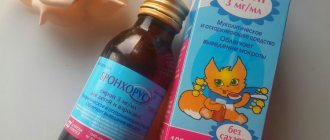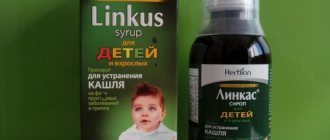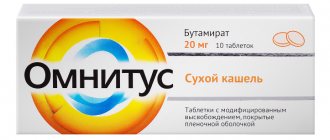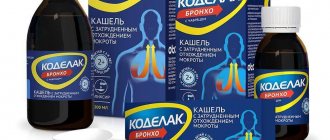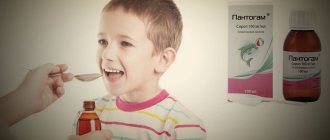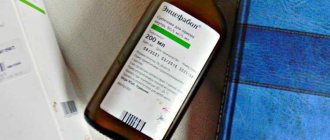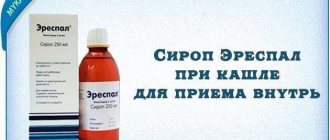Our children quite often suffer from colds, which are almost always accompanied by a runny nose and cough. During this period, the main thing is not to start the disease, but to make the right decision.
For dry and wet coughs, doctors often recommend Ambrobene syrup for children , and today, after reading the instructions for use and reviews, we will talk in detail about what this remedy is and how effective it is.
Release form
According to the instructions for use, Ambrobene for children is available in the following forms:
- solution for oral administration and inhalation;
- syrup;
- pills;
- capsules;
- injection.
As practice shows, for children the most convenient and safe forms of Ambrobene are considered to be an inhalation solution, the dosage of which is selected depending on the age and course of the disease, and the medicine in the form of syrup. And it is this form of release that will be discussed in this article.
At what age can it be given to children?
The dosage form in the form of syrup allows the drug to be prescribed to children from the first days of life. The risk that a child will choke on liquid is very low, since his type of nutrition implies precisely this aggregate state of substances entering the stomach. The drug is diluted with water or given along with breast milk.
Features of the functioning of the gastrointestinal tract in children imply better absorption of active substances in liquid form. Therefore, it is easier for them to take from the syrup everything they need to treat the disease that has arisen.
Compound
The instructions say that Ambrobene syrup is a clear to yellowish solution with a pleasant raspberry aroma. Its main active ingredient is ambroxol hydrochloride.
The following are used as auxiliary components:
- sorbitol solution, which does not crystallize;
- propylene glycol;
- raspberry flavor;
- saccharin;
- prepared and purified water.
Lazolvan or Ambrobene: which is better for inhalation for a child?
The therapeutic effect of Lazolvan is explained by ambroxol. The drug is sold in ampoules, solution for inhalation and oral administration, tablets, syrup, lozenges. The latter can be taken by children over 6 years old; they are convenient to take with you and do not need to be washed down with water. Lazolvan syrup is available in 2 dosages of 15 mg and 30 mg in 5 ml, the latter is not recommended for patients under 6 years of age. Lazolvan Max capsules are also on sale, but they are only available for people over 18 years of age.
Lazolvan costs a little more. The rest of the drugs are similar and you can take any of them.
Operating principle
This medicine belongs to the group of mucolytics or secretolytics, because it promotes the formation of mucus in the bronchial tree. Once in the body, the syrup is almost immediately absorbed and enters the lung tissue.
Next, the active substance (ambroxol hydrochloride) activates the formation of sputum glycoproteins and changes the structure of polysaccharides. This causes the mucus to thin out, making it much easier to cough up.
Ambrobene also helps improve motor activity of the respiratory tract. It affects the ciliated epithelium, increasing mucociliary transport, so the cilia located on the cells begin to actively move, and expectoration becomes much easier.
Ambrobene syrup or tablets: which is better?
The tablet form of the medicine implies that the patient is over 6 years old. This is because children may choke or inhale a solid object. Therefore, solutions and syrups have been developed for them. Liquid dosage forms are easier to dose. For them, you can select an individual amount, which cannot be done with tablets or dragees, where the concentration of the active substance used is always fixed.
At the same time, the solutions do not have a pleasant taste and are reluctant to be drunk by children. Syrups are made taking into account the taste preferences of small patients, so there are usually no problems with their use.
For young children, only syrups are suitable.
An older child is able to choose independently what is more convenient for him to take.
Indications
According to the instructions for use, it is advisable to recommend Ambrobene syrup to children if there is a wet cough, the presence of viscous sputum in the respiratory tract, which is difficult to expectorate. This situation occurs in the following diseases:
- bronchitis of various types (acute or chronic);
- bronchial asthma;
- inflammation of the trachea (tracheitis);
- pneumonia (pneumonia);
- various pulmonary pathological processes occurring with obstruction;
- bronchiectosis (pathological widening of the airways, which produces more mucus);
- respiratory distress (distress syndrome) This is a common indication for which this drug may be prescribed to newborns;
- cystic fibrosis.
Contraindications, side effects
The drug should not be used if there are allergic reactions to the substances in its composition. It is also not used in the first 12 weeks of pregnancy.
Other contraindications include:
- malsorption of glucose;
- functional fructose intolerance;
- malsorption of sucrose.
There are conditions in which the use of Ambrobene is possible, but only under the close supervision of the attending physician.
These include:
- breastfeeding a child;
- ciliary dyskinesia syndrome (lack of movement of the cilia of the respiratory tract epithelium);
- peptic ulcer in the acute stage;
- pathologies of the liver and kidneys.
For such patients, the dosage is selected individually, taking into account the characteristics of their diseases and well-being.
If you are intolerant to the components of the drug, as well as non-compliance with contraindications, side effects may occur.
These include:
- Quincke's edema, urticaria, shortness of breath;
- general weakness, headaches;
- low-grade fever;
- anaphylactic shock;
- abdominal pain;
- dyspeptic disorders (vomiting, diarrhea, constipation, flatulence);
- rhinorrhea;
- urinary disorders;
- exanthema.
When the first signs of side effects appear, you should stop taking the drug and consult a doctor to select a similar remedy.
Contraindications and side effects
In the instructions we find information that Ambrobene syrup is contraindicated for use if there is hypersensitivity to the main component or additional substances included in the composition. It is also not recommended to take it if you have:
- convulsive syndrome;
- stagnation of mucus and its large quantities in the respiratory tract;
- stomach ulcers or other diseases of the stomach and intestines;
- liver failure;
- serious kidney disease;
- disorders of carbohydrate metabolism.
Many medications have side effects, and Ambrobene is no exception, despite the fact that it is really effective, so the following unpleasant conditions may occur when taking it:
- Constipation or upset. Long-term treatment with this drug may cause heartburn, stomach pain, nausea, and vomiting.
- Allergic manifestations on the skin (itching, burning and swelling).
- Nasal discharge, dry mouth, headache and general weakness may occur.
- Some may experience nervous excitability.
For which cough should you take syrup: dry or wet?
The decision about which cough to use a medicine for should be based on the effect of the active substance. Ambrobene thins mucus and also stimulates the production of secretions by the bronchi, which increases its volume. This is how the lungs are cleared of bacteria and viruses that cause the disease.
In the presence of a wet cough, excessive mucus synthesis will aggravate the patient's condition. Attacks will occur more often, and the amount of sputum will increase sharply. Therefore, Ambrobene is prescribed only for dry mucous membranes of the bronchi or the presence of viscous secretions.
A non-productive cough creates an environment for bacteria to multiply and does not bring relief to the patient.
When using syrup, it becomes moist with a moderate amount of easily separated sputum. This promotes a speedy recovery and also prevents the development of complications.
Instructions for use and dosage
The medicine must be taken orally after meals so as not to irritate the gastrointestinal tract. The dosage can only be prescribed by the doctor, and it depends on the age of the baby. The instructions provide the following information:
- It is recommended to give children under 2 years of age 0.5 scoop (2.5 ml) 2 times a day.
- From 2 to 5 years, 0.5 scoop or 2.5 ml – 3 times a day.
- From 5 to 12 years, 1 measuring spoon (5 ml) - 2-3 times a day.
- Children over 12 years of age and adults in the first 2-3 days of illness, 2 measuring spoons or 10 ml - 3 times, then 10 ml - 2 times a day.
The dosage and duration of treatment may vary depending on the course of the disease, so it is extremely important not only to read the instructions well, but also not to self-medicate, but to consult a doctor.
Did you know? It is also recommended to take plenty of fluids during treatment, this also helps thin the mucus and improves the effectiveness of the drug.
Special instructions for the use of Ambrobene
In case of impaired renal function and/or severe liver disease, Ambrobene is taken under constant medical supervision. Use during pregnancy and lactation . Despite the lack of reliable data on the effect of ambroxol on the fetus and child, the use of ambroxol is possible only after a thorough analysis of the benefit/risk ratio. Before using Ambrobene, you should stop breastfeeding. There is no experience with the use of syrup in premature and newborn babies. For children under 2 years of age, the use of syrup is only possible under medical supervision. 5 ml of syrup contains 2.1 g of sorbitol (corresponding to 0.175 XE) and is a source of 0.53 g of fructose (the syrup should not be administered to patients with fructose intolerance).
Overdose
Ambrobene syrup for children is well tolerated, but in case of overdose the following symptoms may occur:
- nervous overexcitation;
- diarrhea;
- increased salivation;
- decreased blood pressure;
- nausea and possible vomiting.
If for some reason an overdose occurs, it is necessary in the first 1-2 hours after taking the medicine:
- induce vomiting;
- rinse the stomach;
- eat a product rich in fat.
Adverse reactions
Ambrobene can cause the following side effects in a child:
- allergy;
- nausea, vomiting, abdominal pain, indigestion, constipation, taste disturbance;
- temperature increase;
- impotence;
- headache;
- dry mouth and throat;
- runny nose;
- dysuria.
If the solution is injected into a vein quickly, it can cause venous edema.
In case of an overdose of Ambrobene, a child may show signs of intoxication:
- excessive excitement;
- stomach upset;
- hypersalivation;
- nausea;
- vomit;
- drop in blood pressure.
If the medicine was taken orally and no more than 2 hours have passed, the victim is recommended to rinse the stomach. The antidote for an overdose of Ambrobene is unknown, so the child is prescribed symptomatic therapy.
Interaction with other drugs
You cannot take Ambrobene and antitussives at the same time. This can provoke stagnation of sputum due to the fact that the latter inhibit the cough reflex.
When taking syrup and antibacterial agents amoxicillin, erythromycin, cefuroxime and doxycycline, the concentration of antibiotics in bronchial secretions and sputum increases.
Correct storage conditions for syrup
Medicinal substances should be stored in places where children do not have easy access. The child is not able to correctly calculate the dosage, so unauthorized use of the drug can cause side effects.
Under the influence of direct sunlight, most drugs disintegrate, which is why their effectiveness is significantly reduced. Therefore, the bottle with syrup should be left in a dark place. The room temperature should not exceed 25 degrees and not fall below 5. Otherwise, the properties of the medicine may change.
Analogs
Analogues of Ambrobene are drugs whose main component is ambroxol hydrochloride. These include:
- Ambroxol;
- Hemofarm;
- AmbroHEXAL;
- Lazolvan;
- Bronchorus;
- Flavamed;
- Medox;
- Ambrosan;
- Halixol.
Pharmacological properties and indications for use
Ambrobene cough syrup combines several medicinal effects.
These include:
- mucolytic (thinning of sputum);
- expectorant (helps remove pathological bronchial secretions);
- secretory (increases the secretion of mucus by the bronchi, which helps cleanse them);
- surfactant-forming (allows you to avoid irreversible changes after recovery).
The properties of the drug are due to the action of the active substance - ambroxol (a metabolite of bromhexine). It also stimulates the maturation of the lungs when they are damaged in children born prematurely. The drug prevents the destruction of surfactant and also triggers its synthesis.
Based on medicinal effects, Ambrobene is prescribed in cases where:
- the child was born prematurely, which resulted in the development of distress syndrome;
- there is an acute respiratory disease associated with sputum retention or insufficient functioning of bronchial secretory cells;
- chronic pathology of the respiratory system enters the acute stage or causes discomfort to the patient.
The action of the syrup is aimed at alleviating the child’s condition, improving sputum discharge or maturation of lung tissue.
Reviews
We bring to your attention several reviews about this medicine.
- The child of user Helena_M is 5 years old and often suffers from a dry cough. They tried many different remedies, but it was Ambrobene syrup combined with plenty of drinking that really helped. It helps not only children, but also adults, it tastes good and is easy to use.
- Margo_B has a 2.5 year old son. The cough began to plague me before the age of 1 year, and then the doctor advised me to try this remedy. The result was pleasantly surprising, the drug is really effective, they still use it if necessary. But for there to be an effect, you need to drink a lot of fluid, doctors don’t talk much about this, so she advises you to carefully read the instructions and read them in detail.
- A user with the nickname Matryona Vasilyevna has two children, and in the autumn they often get sick. Recently, the youngest began to have a wet cough and, already having experience, she gave him Ambrobene in the form of syrup. After just 3 days, the condition improved significantly, and the baby easily coped with phlegm.
- Kissunia shares her story. She treated her daughter with this remedy twice. The first time the therapy was comprehensive and helped, the second time the girl ate too much candy, and due to allergies she developed allergic laryngitis. Treatment was not possible, and Ambrobene came to help. The cough went away in just a few days. So the medicine did its job.
- The user ✘odyayaEmotsia has 2 children, and it so happened that they and their mother got sick. We were treated with various drugs, but the cough did not go away. She went to the pharmacy and was advised to take syrup. Already on the third day there was a positive effect, and the little ones’ cough went away. Convenient, pleasant taste, and the effect really works.
Ambrobene
Ambrobene (ambroxol hydrochloride) is a drug that facilitates expectoration of sputum and has mucolytic activity. It is used in otorhinolaryngological practice for acute and chronic respiratory tract diseases, accompanied by impaired production and evacuation of sputum. Impaired removal of mucus from the respiratory tract is one of the key factors underlying the pathogenesis of inflammatory diseases of various parts of the respiratory tract. Stagnation of bronchial contents causes a deterioration in the ventilation and respiratory abilities of the lungs and an increased risk of infection. The production of secretions by the bronchi is an essential condition for the proper functioning of the respiratory system. The composition of sputum produced by the bronchi is complex and depends on the coordinated work and proper condition of a number of physiological links. Inflammation of any part of the respiratory tract (trachea, bronchi) through a compensatory mechanism increases mucus production, with which, in turn, the consistency of sputum changes in the direction of increasing viscosity. Accordingly, the more viscous the sputum, the lower the rate of its evacuation from the respiratory tract. The insufficiency of the drainage function of the ciliated epithelium of the bronchi and trachea contributes to the retention of sputum in the respiratory tract, resulting in the development of cough. In this case, taking antitussive medications will not only not improve the situation, but will also worsen it. And here drugs that facilitate sputum discharge come to the fore and, in particular, Ambrobene as one of the most effective and safe representatives of this pharmacological group.
In most clinical situations, this mucolytic agent is the best choice in the treatment of infectious and inflammatory diseases of the respiratory tract, incl. in patients of the younger age group. Ambrobene is a new generation secretolytic, which is a derivative of bromhexine and has a powerful expectorant effect. Ambrobene does not affect the production of bronchial secretions produced by mucosal cells. It thins mucus by destroying acidic mucopolysaccharides and DNA, while facilitating the passage of secretions. In addition, the drug increases the concentration of pulmonary surfactant, which improves lung compliance, which indirectly improves mucociliary transport and gives a pronounced expectorant effect. At the same time, Ambrobene does not cause bronchial obstruction. The effect of taking the drug is noticeable within half an hour. It is dose-dependent and is maintained at a clinically significant level for another 6-12 hours. Ambroxol is also an antioxidant that protects the cells of the respiratory tract from the aggressive effects of free radicals. Simultaneous use of antitussive drugs with Ambrobene is contraindicated, because in this case, the cough reflex will be suppressed, which will lead to stagnation of sputum in the respiratory tract.
Helpful information
Today, we, as consumers, are offered a wide variety of cough syrups and tablets for children. Some are well acquainted with the medicine Stodal, which is often recommended, while others had to use Linkas cough syrup.
And quite often, doctors suggest trying dry cough syrup, basing their choice on the natural composition and good effectiveness. To be aware of these issues, you can read the detailed instructions for use of these drugs and reviews.
How does your family deal with such an unpleasant symptom as a cough? Have you ever given this remedy to your children? Do you prefer to use Ambrobene in the form of a syrup or solution, which can also be used by children as an inhalation, for example, with saline? Share your experience and leave your comments on this topic, and don’t forget to write reviews about the information you read.
Taking multiple drugs at the same time
Antibacterial therapy, supplemented with Ambrobene, increases the concentration of antibacterial substances in secreted sputum.
The simultaneous use of Ambrobene with antitussives is strictly contraindicated. The liquid sputum produced should immediately leave the lungs and bronchi, thanks to the cough reflex. By suppressing a cough with means such as Sinekod, the patient dooms himself to the development of pneumonia associated with stagnation of mucus from the lungs, where a favorable environment is formed for the proliferation of pathogenic bacteria.
For what reasons can an overdose develop?
An overdose of Ambrobene most often develops as a result of self-medication with this drug or when medical recommendations for taking it are ignored. The most common causes of Ambrobene poisoning include the following.
- Using large doses of the drug to speed up recovery. Some people believe that by drinking the medicine in large dosages, they will speed up recovery and resolution of the cough. As a result, they do not cure their cough and suffer from severe drug intoxication.
- Taking Ambrobene by a child secretly from parents. Ambrobene syrup is sweet and pleasant to the taste, and children, not understanding the danger of such an act, can drink a whole bottle of medicine. All medications should be stored out of the reach of children.
- Combining Ambrobene with other drugs that contain ambroxol. Most expectorant syrups are analogues of Ambrobene, and simultaneous use of identical drugs can cause an overdose. Examples of analogues: “Lazolvan”, “Bronchoxol”, “Ambrolor”, “Ambrohexal”, etc.
What is better for children ACC or Ambrobene?
ACC contains acetylcysteine as the main ingredient. The medicine is available in granules, soluble tablets, syrup, and solution for injection into a muscle or vein. Injections under medical supervision can be given from birth. The mucolytic can be taken orally only by patients over 2 years of age. Acetylcysteine helps with purulent sputum. ACC has a wider scope of application compared to Ambrobene. It is recommended not only for diseases of the respiratory system, but also for inflammation of the paranasal sinuses of the nose and middle ear.
But this does not mean that ACC is better than Ambrobene, since it also has contraindications and can cause adverse events, so the doctor must decide which remedy to choose depending on the characteristics of the patient.
What is better Ascoril or Ambrobene?
Ascoril is commercially available in tablets and syrup. This is a combination remedy, therefore, compared to Ambrobene, it has more contraindications.
Ascoril is not recommended for children with hypersensitivity to its composition, high intraocular and blood pressure, thyroid hyperfunction, liver and kidney dysfunction, myocardial inflammation, heart defects, heart rhythm disturbances, bleeding from the stomach, uncompensated diabetes mellitus, exacerbation of gastrointestinal ulcers. Tablets should not be taken by patients under 6 years of age.
The combination product is more likely to cause side effects, but this does not mean that it is worse; it may be the one that is more suitable.
First aid for overdose
If an overdose of Ambrobene develops, there is no need to wait for the first symptoms of poisoning to appear.
You need to call an ambulance immediately. There is no need to risk the patient’s health and try to cure him on his own. While waiting for doctors, begin providing first aid to the patient yourself. It consists of:
- Removing drug residues from the gastric cavity. To do this, drink several glasses of plain water and induce vomiting. This procedure is considered effective only during the first two hours after consuming a large dose of Ambrobene. After this time, the drug is completely absorbed into the blood, and gastric lavage becomes ineffective.
- Sorbents. These medications are the main helpers for almost all poisonings. You can use any representatives of sorbents, the main thing is to read the dosing rules in the instructions. Examples of drugs: activated carbon, atoxil, smecta, polysorb, sorbex, enterosgel.
- Drink plenty of fluids. The liquid will speed up the elimination of the drug from the body by the kidneys. You can drink plain water or still mineral water.
